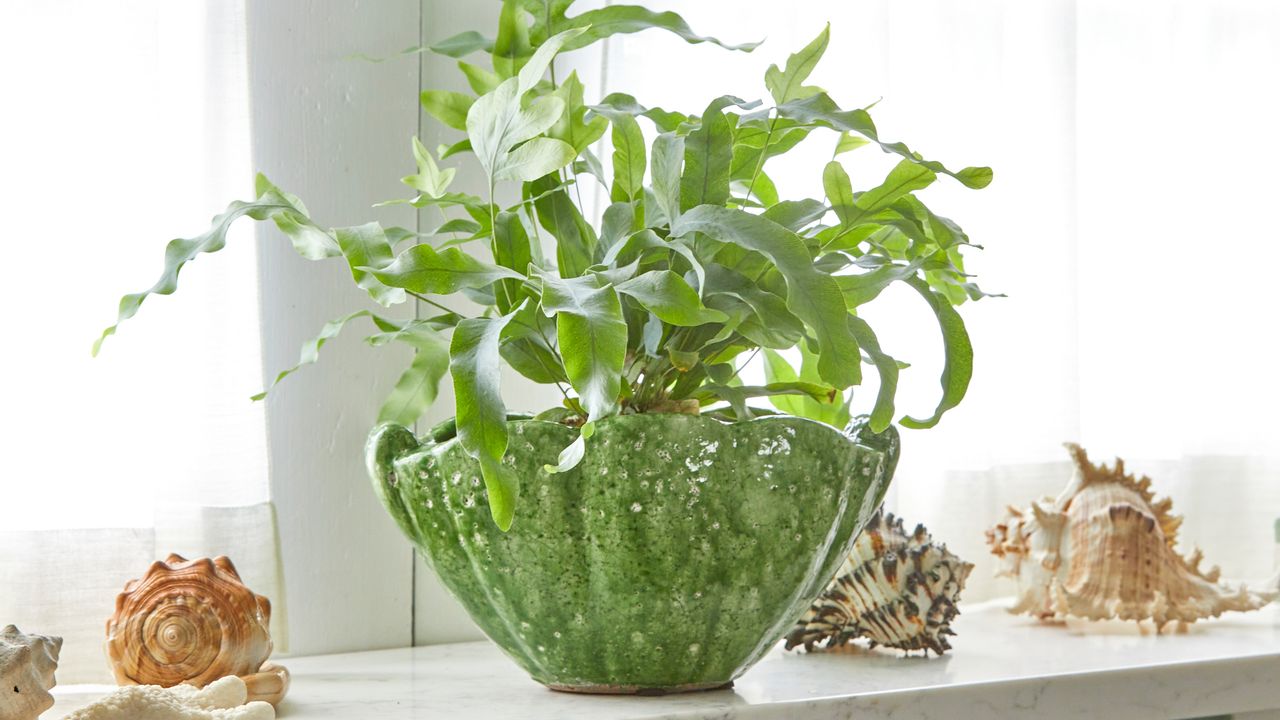How to care for a blue star fern – recreating its natural environment will make them easy to look after
They may be known for being tricky, but a few simple guidelines will change everything


Named for the unique colour of its blue-green wavey leaves, the Blue Star ferns – also known by the Latin Phlebodium aureum – is a beautiful addition to a bathroom or kitchen, thriving in indirect light and a humid environment.
With its unusual leaves, the Blue Star fern would be a beautiful addition to your houseplant ideas. Blue Star ferns have a reputation for being a handful, but the secret to success is to imitate the plant’s native environment.
'Phlebodium aureum is part of the Polypodiaceae family and its native range is SE. U.S.A., Caribbean to S. Tropical America. This epiphytic fern has wavy blue-green fronds and creeping golden rhizomes, the highly lobed fronds can reach up to 40cm in their native environment. This plant's amazing colour is why people call it the "Blue Star Fern",' says Lisa Price founder of Root Houseplants.

How to care for a blue star fern
The experts talk us through what you need to know in order to ensure they thrive in your home.
What you'll need
- Blue star fern
- Pot with drainage holes – one size larger than the size of the plant bought
- A liquid houseplant fertiliser, for example, Baby Bio Houseplant Fertiliser on Amazon
- A trowel
- Loam-based houseplant compost, such as Jazooli Houseplant Compost on Amazon
- Orchid bark, like this Westland orchid mix available on Amazon
- Pebbles
- Round plastic tray
Where to buy Blue Star Fern
Choose your location wisely
‘Blue Star ferns are epiphytic – like orchids – meaning that they grow on other plants, typically on the branches, trunks and in crevices of trees.'
'This means that they thrive in bright but filtered light and wouldn’t enjoy a position in full sun,’ says Kelly Dyer, plant doctor at Patch Plants.
Temperature is also a key consideration. ‘Blue Star ferns like a warm even temperature so centrally heated homes are ideal – aim for around 18ºC,’ explains Sonia Kainth from House of Kojo.
Get the Ideal Home Newsletter
Sign up to our newsletter for style and decor inspiration, house makeovers, project advice and more.
‘If you don’t have the central heating on, place the fern in the warmest room in the house,' continues Sonia 'Avoid drastic temperature changes and draughts. If it is on a windowsill during the day, don’t leave it between the curtains and the window overnight as the temperature drop can prove detrimental.’
‘Positioning your plant in an east-facing window will keep the fronds that lovely shade of blue-green,’ adds Lisa Price founder of Root Houseplants.

Keep them damp
Like most ferns, Blue Star ferns like damp conditions, meaning they need frequent watering in order to thrive. However, it is a careful balance as too much water will lead to root rot and can ultimately kill the plant.
‘Blue Star ferns like to be damp but not sodden so water when the top of the compost has dried out. Fill a container with lukewarm water and submerge the pot until no more bubbles appear, remove and allow to drain before replacing it in the pot cover,’ advises Angela Slater, gardening expert at Hayes Garden World.

Due to their love of filtered light and humidity, Blue Star ferns are a great plant for the bathroom. ‘While they tolerate average household humidity, higher humidity (around 60%) can enhance their growth,’ says Sonia. ‘Contrary to popular belief, avoid misting ferns as they may cause fungal issues and this does not increase the humidity as much as one might think.’
Instead, place the plant in a humid space – like the bathroom or kitchen – or stand it on a pebble-filled saucer that you can top up with water when needed – this creates a humid environment without submerging the soil or roots in water.
Yellow or brown Leaves indicate that the plant has been underwatered – it may need watering more frequently or repotting in a larger pot.
Know when to repot
Since they grow on the side of trees, Blue Star ferns require a free-draining potting compost. ‘Opt for a compost that isn’t too nutrient-rich and that will hold onto some moisture, but not too much. Ideally, this would be loam-based (a balanced mix of sand, silt and clay) with added drainage like bark, grit or perlite, which is pH neutral to acidic,’ says Kelly Dyer.
Only repot your Blue Star fern when it starts showing signs of having outgrown its current pot – this will help you avoid one of the most common houseplant repotting mistakes.
Signs include roots growing through the drainage holes, the soil becoming compacted or the plant looking a little lacklustre. ‘Blue Star ferns typically need repotting every two years. Aim to repot in spring to limit transplanting stress,’ says Sonia.

FAQs
Should you mist a blue star fern?
No, you should not mist a blue star fern. According to Sonia Kainth from House of Kojo, misting the plant can increase the likelihood of fungal infections. Instead place in a humid room (like the kitchen or bathroom) or place the plant on a tray of pebbles and water.
What kind of potting soil for blue star fern?
The best potting soil for a blue star fern is one that is loam-based and well-draining. It should also be mixed with orchid bark and perlite to aid drainage.

Designed specifically for ferns, Grow Tropicals' fern potting mix has been designed to balance moisture retention and drainage – helping the fern to thrive.
What are the dots on my fern?
Large dots under leaves are ‘sori’ from which spores are released. ‘They start of green but turn brown-black as they ripen,’ explains Kelly Dyer. You can use these to propagate a fern but it is a very slow process. If not using, leave them be as removing could damage the fern.

Holly is one of Ideal Home’s content editors. Starting her career in 2018 as a feature writer and sub-editor for Period Living magazine, she has continued this role also adding regular features for Country Homes & Interiors and the Ideal Home website to her roster. Holly has a passion for traditional and country-inspired interiors – especially kitchen design – and is happiest when exploring the countryside and hills of the Lake District. A keen gardener, she is a strong believer that you can never have too many houseplants.
-
 Do you need planning permission for solar panels? This planning expert explains which rules will apply to you
Do you need planning permission for solar panels? This planning expert explains which rules will apply to youMany homeowners question whether or not planning permission for solar panels will be needed – and our guide is here with the answers
By Natasha Brinsmead
-
 Take a tour of this dreamy pastel coloured seaside home on the Dorset coast
Take a tour of this dreamy pastel coloured seaside home on the Dorset coastA bold move to the Dorset coast saw this family completely transform their dated 1980s house into their ideal home
By Marisha Taylor
-
 I slept on the Simba Hybrid Essential for a month – here's why I'm so impressed by the brand's most affordable mattress
I slept on the Simba Hybrid Essential for a month – here's why I'm so impressed by the brand's most affordable mattressMy Simba Hybrid Essential Mattress review puts the brand's most affordable mattress through its paces
By Rachel Tompkins


